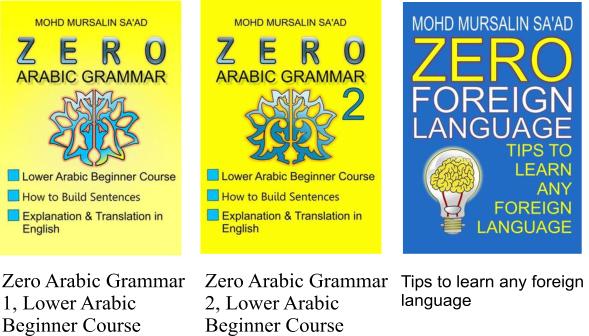
- MozSaad
- September 15, 2023
Here is a short article explaining about Arabic usage and expression of Arabic words.
Arabic grammar is a complex and intricate system that plays a crucial role in understanding and analysing the Arabic language. To navigate this vast subject, it is essential to have a solid grasp of the fundamental concepts and principles that form the basis of Arabic grammar.
1. Nouns: Nouns are at the core of Arabic grammar. They are classified into different categories, such as proper nouns (Ism al-Maqṣūm), common nouns (Ism ʿĀmm), and dual nouns (Ism al-Muthanna). Whereas plural nouns is called (al-jamae). While English by adding ‘s’ at the end of the word. When you are formatting Arabic sentence the forms of nouns should be kept in mind when building sentences. Start to memorize some nouns plus knowing the plural form. The dual form is easy that is by inserting the suffix (alef and nun) at the end of a single noun. Understanding the various types of nouns and their grammatical properties is vital for constructing sentences accurately.
2. Verbs: Arabic uses direct form of verbs, that said, it has 14 forms of morphology, which is used to directly say a verb integrating within the verb a pronoun. Verbs are another cornerstone of Arabic grammar. They express actions, states, or occurrences. Arabic verbs are conjugated based on tense, person, and gender. Learning the different verb forms, such as past, present, and future, is essential for constructing meaningful sentences.
3. Pronouns: Pronouns are words that replace or refer to nouns. In Arabic grammar, there are different types of pronouns, including personal pronouns (Dhāt), possessive pronouns (Ism al-Malak), and demonstrative pronouns (Ism al-Ishāra). Understanding the correct usage and agreement of pronouns is crucial in Arabic grammar.
4. Syntax: Syntax refers to the arrangement of words and phrases to create grammatically correct sentences. Arabic follows a specific word order, which is different from English. The subject usually comes before the verb, and adjectives usually follow the noun they modify. Mastering Arabic syntax is essential for constructing coherent and meaningful sentences.
5. Cases: Cases, also known as declensions, are grammatical inflections that indicate the role of nouns or pronouns in a sentence. Arabic has three cases: nominative (al-Marfūʿ), genitive (al-Majrūr), and accusative (al-Mansūb). Understanding the different cases and their corresponding endings is crucial for accurate sentence construction.
6. Prepositions: Prepositions are words that show relationships between nouns, pronouns, and other words in a sentence. Arabic has a wide range of prepositions that are used to convey various meanings. Understanding the correct usage and placement of prepositions is vital for expressing precise meanings in Arabic.
7. Agreement: Agreement refers to the matching of grammatical features, such as gender, number, and case, between different parts of a sentence. Arabic is a highly inflected language, and words must agree with each other in various grammatical aspects. Mastering agreement rules is essential for constructing grammatically correct sentences.
These keywords represent the fundamental aspects of Arabic grammar. By understanding and applying these concepts, learners can begin to navigate the intricacies of the Arabic language and communicate effectively in both spoken and written forms.
How do Arabic use verbs morphology?
In Arabic, verbs are typically formed from a set of consonants called a “root.” These roots consist of three consonants, and verbs are formed by adding various vowels, prefixes, and suffixes to these roots. The root system is fundamental to Arabic grammar and allows for a wide range of verb forms. Here are some examples of root verbs in Arabic:
1. **K-T-B (كتب)**:
– The root K-T-B is associated with the idea of writing.
– **Kataba (كَتَبَ)** means “he wrote.”
– **Kutub (كُتُب)** means “books.”
2. **D-R-S (درس)**:
– The root D-R-S is related to the concept of studying or learning.
– **Darasa (دَرَسَ)** means “he studied.”
– **Madrasa (مَدْرَسَة)** means “school.”
3. **R-K-M (ركم)**:
– The root R-K-M is associated with the idea of throwing or casting.
– **Rakama (رَكَمَ)** means “he threw.”
– **Mirkab (مِرْكَب)** means “vehicle.”
4. **S-L-M (سلم)**:
– The root S-L-M is linked to the concept of peace or submission.
– **Sallama (سَلَّمَ)** means “he surrendered” or “he submitted.”
– **Salaam (سَلام)** means “peace.”
5. **N-S-R (نصر)**:
– The root N-S-R is associated with the idea of victory.
– **Nasara (نَصَرَ)** means “he helped” or “he gave victory.”
– **Nasr (نَصْر)** means “victory.”
6. **Q-R-A (قرأ)**:
– The root Q-R-A is related to reading.
– **Qara’a (قَرَأَ)** means “he read.”
– **Qur’an (القُرآن)** is the holy book of Islam, which means “the recitation.”
These are just a few examples of root verbs in Arabic. The Arabic language has a vast and complex system of verb conjugation and derivation, allowing for a wide range of meanings and nuances to be expressed through verbs. By changing the vowels and adding prefixes and suffixes to these root consonants, Arabic speakers can create numerous verb forms to convey various actions and states.
Underwater world sea creature t-shirt series



